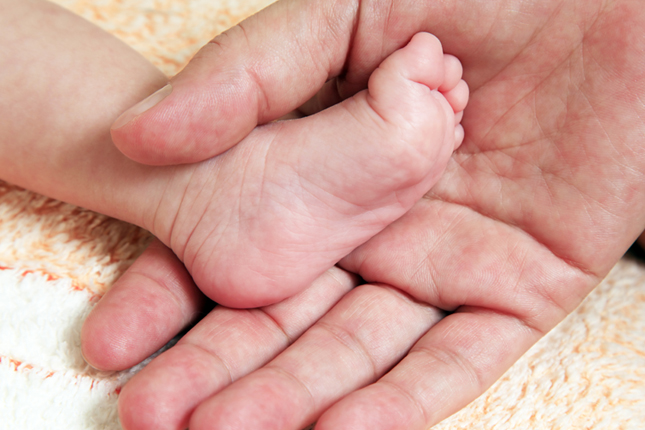Parent Savers
Newborn Screening Tests
[Music]
Dr. Tara Zandvliet: Newborn screening identifies conditions that can affect a child’s long-term health or survival. Early detection, diagnoses, and intervention can prevent death or disability and enable children to reach their full potential. I Dr. Tara Zandvliet, a pediatrician who performs newborn screening tests, and this is Parent Savers, Episode 43.
Sunny Gault: Welcome to Parent Savers broadcasting from The Birth Education Center of San Diego, I am your fill-in guest host, Sunny Gault. I’m also the host of our sister show, Preggie Pals, which is focused on pregnancy and those hoping to become pregnant. Are you a member of the Parent Savers Club? Our club gives you access to all of our episodes plus free bonus content after every new show, and giveaways and discounts. You can sign up on our website, parentsavers.com, and that’s also where you can subscribe to our monthly newsletter-which puts you in a drawing each month for a free membership to our club. I am a new parent, I have two sons. Sayer who is two and a half, and Urban who is ten months old, and I’m joined here in the studio by one other new mommy. I’m going to call you a new mommy, because you’re still kind of a new mommy-Hillary. Hillary, tell us about yourself.
Hillary Gardner: My name is Hillary Gardner, I am a self-employed children/baby/newborn photographer, Stills by Hill Photography. I am thirty years old, and I have four year old little girl named Lilliana who thinks she’s twenty.
Sunny Gault: I thought it was so funny when I’d seen your Facebook posts, I thought “Oh, she has her hands full!”
Hillary Gardner: No joke.
Sunny Gault: She’s such a cutie, but oh my goodness.
Hillary Gardner: No joke.
[Music]
Sunny Gault: Alright here is a headline that is making rounds around the internet, and I just could not believe it when I read this. Ok get this: There is-Dulce and Gabona-they have a new perfume coming out for babies. It is designed for babies. It is a new citrus, melon, and honey fragrance, and it’s supposed to be sold for twenty-eight Euros-which I have not done the math, it’s probably ridiculously expensive, isn’t it like twice as much in Euros or whatever- and again, it’s focused on babies, like one year olds. And I’m just wondering what you guys’ thoughts are on that. Do babies need perfume?
Hillary Gardner: Doesn’t everybody love the baby-the new baby smell? My question is first off what is in it? Why does a baby need that? Because it’s spray, and it’s going to get into their skin!
Sunny Gault: Its scents-and it says that the perfume will be unisex. It won’t contain alcohol, so it’s not supposed to irritate the baby’s skin, and 50ml bottles that it’s going to be sold in.
Hillary Gardner: I say negatory on that. [Laughs]
Dr. Tara Zandvliet: I say negatory, too. I mean, kids are sensory sponges, they’re supposed to be smelling flowers at this age; they’re supposed to smelling dirt, the world after a rain. All these things go into their brain and they help make the brain develop better. I don’t know what the brain will develop on perfume. You know what I mean?
Sunny Gault: That’s a really good point.
Hillary Gardner: That’s crazy.
Dr. Tara Zandvliet: Yeah. That’s nuts.
Sunny Gault: I thought it was crazy, too. But then consider this, if you use fragrance free stuff on your kids then this may not apply to you, but I have baby lotions that are scented like special nighttime stuff that’s supposed to make them sleep better and blah, blah, blah-and that has a fragrance in it. So is it so weird if we’re already putting fragrances on our babies?
Hillary Gardner: But see, if you’re using a lotion, you’re using that for their skin. So there’s a need.
Sunny Gault: So there’s an added benefit.
Hillary Gardner: Right. If you’re just putting a perfume on them for the heck of it-why? Do you know what I mean? I mean, spray it around their diaper pail. [Laughter] We don’t need to spray them. I mean I buy everything that’s fragrance free-I don’t do any additives-so this would, I would be like “Oh, heck no.” I would probably post it on Facebook and be like, what are they thinking?
Sunny Gault: Actually, I did. I posted it on the Parent Savers page, so you guys should go comment on it. All of our listeners should go comment on it and give us your thoughts because it is coming to market.
[Music]
Sunny Gault: Ok, today on Parent Savers we have Dr. Tara Zandvliet, and she is a pediatrician right here in San Diego. Welcome to the show! I’m going to call you Dr. Z, because you like that.
Dr. Tara Zandvliet: Yep, that’s what I like.
Sunny Gault: Dr. Z! Ok, we are talking about newborn screening tests today. Let’s just dive into this. So what are newborn screenings and what are we trying to accomplish here?
Dr. Tara Zandvliet: Well a newborn screening is a blood test that we do on babies within the first week of life, and what we’re trying to do is find these really rare, really devastating diseases early-so we actually intervene and prevent some of the horrible complications like mental retardation, seizures, and death. You know, these are diseases that within the one month of life-before you even see the pediatrician in the office for their two month visit-your baby could already be mentally retarded or have seizures. Most of the time, with these diseases they would come to the Intensive Care Unit in about two weeks of life, and it was already too late to do anything. So we’re trying to find it within the first week of life really, to intervene. And a lot of these diseases, the food is the problem, and the food is breast milk. And so, we need to find those babies that can’t drink breast milk.
Hillary Gardner: Oh, those poor babies.
Dr. Tara Zandvliet: I know! It’s awful!
Hillary Gardner: I have friends who have gone through this, and they’ve had to-they’re dream was to breastfeed- and then their baby has all these problems and they have to spend ridiculous amounts of money every month on specialized formula, and it breaks my heart. Their heart, too.
Sunny Gault: Oh my goodness. Ok. So if we can find these diseases earlier, we can treat them earlier, and then they can overall be healthier, that’s the idea?
Dr. Tara Zandvliet: Exactly. They had an actual like kid, two kids in 2003 in California-weirdly they had the same name; first name anyway-and one was born in a hospital that was doing screens, one was born in a hospital that was not. The reason was it was an experimental part of-you know-they were trying to figure out if they should add it in. The one who was found within the week changed diets and is perfectly fine today. The other one wasn’t found until about a month later; pediatrician picked up-and these are hard for pediatricians to pick up, these are not normal diseases-
Sunny Gault: Yeah.
Dr. Tara Zandvliet: We get tested on them every seven years just to remind us that they are still out there, and if you’re lucky, you’ll see one in your career. So, he picked it up, but the mental retardation was already there, and he was already crippled-he can’t walk.
Sunny Gault: Oh no.
Dr. Tara Zandvliet: Yeah. One month old, and they couldn’t do anything. Now, it won’t progress, it won’t die. But-so that’s an example right there of the intervention. Changing the diet within a week of life-normal kid, not as normal kid.
Sunny Gault: Right. Now, are these things that we can’t test for prenatally? Because that’s a whole other separate test, obviously.
Dr. Tara Zandvliet: You can get a genetic test done for most of these as a mother-a pregnant mom- or even as a going to be pregnant mom. Any woman who wants to, any man who wants to can get a genetic test. They can run expensive. They can run for one of the basic prenatal screenings, $350, for a full extensive over $1000. But you can, you can find out if you are a carrier. But that only tells if you are. Almost all these diseases are recessive, which means dad’s got to contribute a gene and mom’s got to contribute a gene. And so you can tell-I guess both of you, mom and dad could both get tested, and if you guys both tested clear, there’s really not much of a reason. There are a couple of diseases that are not genetic, and the screening would be good for that. But other than that-yeah, you can get a test as a parent.
Sunny Gault: And who determines what goes on this list? [Laughs]
Dr. Tara Zandvliet: There is a panel of-and I believe there are-doctors, public health specialists/masters of public health, and many of them are dual. So they’re masters of public health and they’re physicians. So they kind of go through and the interesting thing is the-I’m not sure actually what the name of the panel is in California-but they have criteria. There are four criteria that they go for: the disease has to be severe, the disease has to be easily identifiable with a test that is reliable, it has got to have an intervention that will make a difference-because why test it just to know? What’s the point of that, right? So you’ve got to have an intervention like diet or a medication that will make a difference, and then you’ve got to know the natural course of the disease. If you don’t know what the disease does, why test for it? If the disease cause death, that’s a good reason to test for it.
Sunny Gault: Right, yeah. That makes sense. And then how often do they change up these lists?
Dr. Tara Zandvliet: Oh gosh, sometimes yearly.
Sunny Gault: Oh, really? They keep you guys on your toes!!
Dr. Tara Zandvliet: Exactly. They have a core group, they are-well, the first one was PKU-yes phenulketonuria-that was the very first one. You know on every diet soda can you see, it says “phenulketonurics, this product contains phenylanine.” Ok, that’s-they’re telling you because these kids cannot drink any diet sodas. No NutraSweet whatsoever because it has that amino acid in it. But that’s been on there since the early sixties, that was the first one. Then in the seventies they added a few others. Eighties-a lot of them, couple more; 1995-2000 a lot of them got put in because they invented a new way to test things, so they put in a whole bunch. But gosh, I think last year-they added an infection toxoplasmosis-and it makes the pediatricians life a lot easier, because I remember you know, in the hospital when they baby was born-that first day we’re looking for all of that. We’re looking for with toxo-this is the one where-this is why pregnant ladies are not allowed to change the kitty litter-that’s toxoplasmosis. And we used to have to do all sorts of physical exams for the kids and stuff, looking, and now you just do the test. It makes it a lot easier not to miss it.
Hillary Gardner: How accurate is the testing, I mean the results? Because I’ve heard of situations-like pregnancy testing for instance-where someone’s told their child has Downs, or whatever. And they’re like let down, and then the baby comes and they do the test again and the baby’s fine. So….
Dr. Tara Zandvliet: I had that happen to me, so yeah.
Hillary Gardner: Yeah. So how accurate are the test at….you know?
Dr. Tara Zandvliet: It’s a screening test, so it’s not the definitive test for the disease. So, if these tests are positive, you always get the real test for the disease. Unfortunately that means real blood out of the arm instead of a heel stick, but it’s worth it because there are false positives. They are looking for-you know-how your body, how the baby’s body, uses the food. How it breaks down the vitamins, how it uses the vitamins-so that’s what they’re…they’re screening for things. So if someone’s is positive, then you do the more definitive test. They have probably-you know I don’t even know really the percentages that are wrong-I’d say there are more false negatives. So there are more tests that look normal that then there’s a problem later. Luckily, they’re usually mild. But it’s something that’s-not one of the really bad ones-but that’s why you go to the pediatrician, because we’ll catch it if the screen missed it. But there are some false positives, yeah, definitely. Not many, but there are.
Sunny Gault: Is every newborn screened? Is it a requirement? Can parents opt out of this?
Dr. Tara Zandvliet: It’s a requirement, but yes you can opt out for “religious reasons.” I go broadly on that. [Laughter] But anyway-“philosophical objections.” But anyway, you have to sign a form. So, usually the person’s who’s drawing the blood-doing the heel stick- will make you sign a form that says you are refusing, and if the child dies because of one of these disease that could’ve been caught, it’s your fault and not the states fault for not forcing you. But yeah, there are a lot of people who object for many different reasons-and yeah, they’re not screened.
Sunny Gault: And it’s not like you have to give birth in a hospital to get these, because Hillary I know that your experience was a little bit different, not in the hospital.
Hillary Gardner: I gave birth at Best Start, which is a local birth center-and was questioning every single little intervention or any single thing that my daughter was going to have to go through-so we did make our choices on what we wanted to do, what we did not want to do/we wanted to opt out of-what we said absolutely no to. And I did question the screening, for quite a few reasons, and then my husband just said “Just do it, it’s just a little tiny prick, you’re not injecting anything.” Like you said-you’re not injecting anything so yeah, the midwife came to my house a few days later and did the little prick, and then called just a few days later and said everything was good, and then we moved on.
Sunny Gault: Ok, now-so that leads me into the next question-how are these tests performed? It’s just a heel prick?
Dr. Tara Zandvliet: It’s a heel prick. Basically, what they’ll do is they’ll put, usually-well I prefer-is they’ll numb it up. To use a little cream or I like using little freezy spray or an ice cube-kind of make it a little numb. Although, an ice cube can be a problem because then they don’t have a lot of blood. [Laughs]
Sunny Gault: Then you’re freezing the blood.
Dr. Tara Zandvliet: Generally, I’ll try to put on a little anesthetic cream and then put a heating pad on. And then, the worst part for the baby-other than the poke, because nobody likes being poked-the worst part is having your foot held and squeezed. So they don’t like the squeezy thing. I usually have them breastfeed-you know, go ahead and have them breastfeed-you make sure they’re hungry. So I have them breastfeed and I hold their foot and poke the heel and then I have to keep pressing this little paper-cardboard kind of thing-where I have to fill up five little holes. No, not little holes, circles on the paper-and I have to completely fill them with little drops of blood. And it’s interesting because it is a puncture poke, and so the scab lasts forever. You know, moms will come in: “It’s been three weeks. The scab has not come off yet.” I’m like “I know.” Because it heals from the inside out, it has to push the scab out. So it’s healing slowly. But you had a great thing....
Hillary Gardner: We just dropped breast milk on any little scab, anything that…
Sunny Gault: Which I’m just learning that you can do this topically.
Hillary Gardner: Yes, breast milk is liquid gold.
Dr. Tara Zandvliet: It is, it really is.
Hillary Gardner: It’s amazing. I used it for everything. And even when I stopped nursing, I had to call friends and ask them for breast milk because my daughter got a cut or something. [Laughter]
Sunny Gault: Ok, so, about the scab and all that stuff. So, my two and a half year old, believe it or not, still has-not a scab anymore-
Dr. Tara Zandvliet: A dent.
Sunny Gault: Well, no, it’s a red dot! Like it just happened yesterday, and it is on his heel, and he is two and a half years old.
Hillary Gardner: I’ve never checked to see if my daughter still-I’ve never paid attention.
Sunny Gault: Oh, Urban, my second, he has nothing. But Sayer has, and he will probably always have this-and it makes me mad every time I see it.
Dr. Tara Zandvliet: But you know what it is? It’s a tattoo! [Laughter] Essentially, when they poked they probably broke open one of the little blood cells, and hemoglobin is traditionally of the-you know blood is one of the ways that they used to tattoo in the early primitive days. So he’s probably got a teeny tiny dot tattoo. [Laughs]
Sunny Gault: Oh my gosh. I know, it’s like looking at him-“that can’t be what I think it is!” But yeah, it never went away.
Hillary Gardner: Oh how funny.
Sunny Gault: I know. Alright, when we come back we’re going to talk about the main conditions that the newborn screening tests are testing for. We’ll be right back.
[Music]
Sunny Gault: Welcome back, everyone! We are talking about newborn screening tests today. Dr. Tara Zandvliet is our expert today, our expert pediatrician, and in the first part we were talking about screening tests: what they are, why you need them, what’s involved. So now we’re going to dive into these conditions that we’re testing for, because I think it’s important for us as parents to know; if we do these tests, what are we looking for? And I know that a lot of these are few and far between that your kid will get this, but it is possible that we would be testing for them, right?
Dr. Tara Zandvliet: Right.
Sunny Gault: Right. So let’s go through these, and I’m going to let you take the lead on this a little bit.
Dr. Tara Zandvliet: Sounds good. First, in terms of rarity I looked up the statistics for California, and since 1980-so what thirty-some years?- they’ve diagnosed about ten thousand of these kids. And so there are ten thousand of these kids in California alone that are better off in terms of their diseases. They were found early. These are not false positives; these are ones who’ve had the disease who have had an intervention and are doing better. It’s about one out of every four thousand kids born who will have something. So again, it’s pretty rare. The diseases are kind of broken up. The way I think about things, I try to categorize. The biggest one I think-there’s endocrine, which is like hormones; metabolic, which is how your body uses food; hemoglobin, which is your blood-your anemias; and then some random genetic things like cystic fibrosis; and then now they’re starting to do infections like toxoplasmosis. So, I kind of them in those five categories. So endocrine-wise: everyone’s heard of low thyroid, right? We’d love to blame it for why we can’t lose those last ten pounds after the birth. [Laughter] And, you know, babies can be born without a thyroid.
Hillary Gardner: Really?
Dr. Tara Zandvliet: Yes, and often if a mom has high thyroid, especially while pregnant, it turns of their thyroid, and the baby can be low thyroid. So, it’s about one out of every two thousand babies born, and they grow really, really slowly-and they’re short, they’re heavy, and the biggest danger is they are mentally retarded-the longer they go…
Sunny Gault: Is that related to -I’m sorry to interrupt-is that related to gestational diabetes?
Dr. Tara Zandvliet: No, not at all. Zero. Yay! [Laughter]
Sunny Gault: Right? [Laughter]
Dr. Tara Zandvliet: And there’s no real blame in any of these diseases, by the way. There’s nothing you can do in pregnancy to prevent them. There’s nothing you can eat, there’s no supplements you can have that will prevent these. If your baby’s going to born without a thyroid, they’re going to be born without a thyroid.
Sunny Gault: So it is what it is.
Dr. Tara Zandvliet: It is what it is.
Hillary Gardner: So if the baby’s born without a thyroid, like one of my cousins had to have her thyroid removed so she has to be on medicine for the rest of her life. So is that-the baby’s going to have to be on medicine for the rest of their life?
Dr. Tara Zandvliet: Yes.
Hillary Gardner: Holy bananas.
Dr. Tara Zandvliet: I know, I know. But with the medicine, you’re just replacing the hormone they don’t have. Ya, you just take a pill. The kids will crush it and stick it in a liquid; they do really well with it. And they can have normal intelligence, they can actually do extremely well: we’ve got quite a few that are physicists and, you know, amazing.
Sunny Gault: So it literally can just replace it.
Dr. Tara Zandvliet: Literally just replace it. The other big endocrine one is called congenital adrenal hypoplasia, and it’s basically when there’s too much testosterone around, essentially. There’s a block in the whole hormone cascade, so instead of making a balance of estrogen and testosterone, you just make testosterone. And so girl babies get teeny tiny penises, and it’s really traumatic to them. That you can’t prevent, because you can’t diagnose it in pregnancy, generally. Maybe if you had your correolonic fillide sampling, but pretty much you don’t know until they’re born, and then you’re like, what the heck? It’s very traumatic. But one of the big keys of it is, you can-there’s a subset of kids, girls that do not keep salt in their bodies. So they have seizures and they can die very quickly. So usually, by eight days of life, they die. I mean if it’s the full on-there are partials, you can have two or three or four months old, and they’re just not doing well, but they can die within eight days of life. And you’re completely, completely fine with the salt stuff if you give them-actually weird-a steroid. So they’re on steroids the rest of their life. But, it’s a different type; it’s not that kind of steroid.
So metabolic diseases, the other big category, there are hundreds of bizarre diseases. Like biotinidase deficiency is vitamin B-you know your B vitamins, your B complex. What if you couldn’t use that? What if you can’t use your vitamin B? What happens to your body? You feel like dirt, basically, but-hearing loss, you have vision problems, you don’t have depth perception, things like that. And they can die eventually, although usually not, they just are very slow and they do have diarrhea and they don’t gain weight. So that’s one. There’s a bunch like that where you can’t use vitamins. The most traditional one is called phenylketonuria, which is don’t drink diet coke. But the thing we don’t realize, it’s like “Well, so they have PKU, I just won’t give them any NutraSweet,” except that there’s phenylanine in breast milk. So the babies cannot drink breast milk, and again they can die from not being able to metabolize that. So, you’ve got to catch them within one month, within a month. Get them off breast milk, get them off all milk. You’ve got to have a really special, expensive of course, formula for them. And they do fine-beautiful, intelligent kids-normal, if they can have the right diet, and that’s why of course they have the warnings on the cans.
Another one is galactosimia. The lactose is one of the sugars in milk, and they to break it down into the basic sugars-you know, glucose and fructose and stuff. They can’t do that. So, they end up with major diarrhea because they can’t absorb it, and again they cannot have milk. The most of them will die by one month. The other one-I just love the name-maple syrup urine disease. Yes, indeed, the urine smells like maple syrup. It’s like you’re in Vermont.
Hillary Gardner: It could smell like worse stuff, really.
Dr. Tara Zandvliet: You know really? It could. It could.
Hillary Gardner: Like asparagus pee.
Dr. Tara Zandvliet: I know right? There’s also a sweaty sock urine disease.
Hillary Gardner: Nu-uh!
Dr. Tara Zandvliet: They never mention that one, but it smells like sweaty socks. Literally, their urine smells like sweaty socks.
Hillary Gardner: Who names this stuff?
Sunny Gault: I know! It’s very technical. [Laughter]
Dr. Tara Zandvliet: I know, right. “This is real medical term.”
Hillary Gardner: I mean, you went to college for this?
Sunny Gault: That’s what I would name things if people let me.
Hillary Gardner: That’s like a hundred thousand dollars of student debt to learn this. [Laughter]
Dr. Tara Zandvliet: Exactly, to learn this. But, yeah it smells like Vermont in your baby’s diaper. It’s just-you know-but yeah, and the get seizures, mental retardation, death again. There’s another one splitting fat-medium chain acyl CoA dehydrogenase deficiency, or MCAD - they just can’t break down any fat. Which of course, fat is in breast milk.That’s why these are important; because what is their basic food for life is killing them. Another one is hemoglobin, so that is anemias. These kids actually have a gene where their hemoglobin’s not normal. So have you ever heard of sickle cell disease? Sickle cell anemia? So, thought there are many other ones, there is beta thallasema now, hemoglobin H-there’s a whole bunch of genetic defects that basically make their hemoglobin do weird things, and they don’t make nice little round red blood cells that go through our blood vessels really cool. They look all weird, and they get caught in the blood vessels, and they actually can cause strokes. They can cause kidney failure, heart failure-those babies by the time they’re about two or three months old need a blood transfusion. Because they’re blood is just really going to town that first couple of months and so a lot of times we have to do that. And then, we just have to monitor them, we have to know who they are so that we can do a little poke and check and make sure they’re not too anemic, because again they can have strokes, they can have heart attacks and it’s just-it is a lot of damage that can be done there.
And then other genetic tests: cystic fibrosis. People think of cystic fibrosis as with the lung; it’s like bad asthma with horrible phlegm, infections and pneumonia. They eventually die of pneumonia, usually by the time of twenty something. But on e of the weird things is that the first thing you notice is digestion, because they don’t digest well. They don’t have all of the enzymes-the secretions are really thick, and block them up-so they get intestinal blockages, they get diarrhea, and they can’t absorb protein. And now they’re just starting to test for infections like toxoplasma-you know the “don’t clean out your kitty litter,” [Laughs] “don’t eat raw meat” thing. That infection, which can cause cysts in the brain, seizures, mental retardation, rashes-horrible rashes, blindness, all sorts of things like that.
Sunny Gault: How quickly do parents get the results if something comes back abnormal? How quickly would we know?
Dr. Tara Zandvliet: There’s the key. If they’re normal, it may be months before you get the results, because that’s not they’re priority, you know? The pediatrician can usually log on and get the results, we get them pretty fast. The hospitals-if you’re born in a hospital or a birth center they get the results pretty fast. In a week-usually by a week, two weeks maybe. Parents get them pretty much a couple months’ later and you’re like “What is this? I don’t even remember what that test was.” But if it’s positive, some of the state workers-the people who are monitoring this-they literally go and find you. They’ll call the pediatrician, they’ll call the hospital; they go and call you on the phone. If your phone number is disconnected, they will come out to your house. If you have moved, they will go and look on every-you know online-they will desperately try and find the baby. And they are really good at finding them, especially because they know within days; so if you have it done on day three of life, by day six or seven of life they’ve got the result, and so it’s unlikely you’ve moved. So almost always they can find you. Yeah.
Sunny Gault: Ok. So it’s that quick, but it needs to be.
Dr. Tara Zandvliet: Yes, it has to be.
Sunny Gault: Because again, breast milk-and you’re probably already feeding your kid. What would you say to parents, how can they better prepare themselves for these screening tests? Or is there any advice that you would give them, for someone who’s kind of on the fence? Someone who doesn’t really know what they want to do yet?
Dr. Tara Zandvliet: I guess the biggest-you know the controversy always is that, well a couplefold- but the big one, most parents are “I don’t want my baby poked.” If you’re breastfeeding while they do it, most of that pain is mitigated. It’s been shown that breastfeeding is a huge pain reliever for babies. So, if you do that, at least you can do that. And then you don’t have to worry about a lot of these diseases. If you don’t get it done, again, we will know at some point that your child is sick; I mean it’s going to become pretty obvious. It may take a while, and a lot of expense and a lot of hassle trying to figure it out. Because these are really rare, and I remember before we had the screening test we’d get these kids in the ICU, they’d just had a seizure, they’re on life support for a little while; and we’re sitting there going “What the heck?” You know- yes, if you don’t get the screening test, you can definitely find out that your child has a problem, it’s not like we will miss it. But it may be too late at that point to reverse some of the mental damage or some of the problems.
Sunny Gault: Ok. Well thank you, Dr. Z, for sharing all this information with us today. To learn more about Dr. Zandvliet, our panelists, and to learn about the different resources that you can get for more information: you can visit our website, parentsavers.com. Our conversation will continue after the show for our Parent Savers Club members. We will be discussing a little bit more about what happens if you choose to decline newborn screening tests.
[Music]
Sunny Gault: Before we wrap up today’s episode, here’s Amy Sorter with some environmentally friendly parenting tips.
Amy Sorter: Hell Parent Savers, I’m Amy Sorter, eco-previewer and co-founder of ecosavvymoms.com, where you can find information on your family going green, saving money, and looking great doing it. Today we’re going to talk about ways you can clean your home the natural way, and stop using harmful, toxic chemical cleaners. You know, as soon as I became pregnant, I realized how important it was to detox and green my home and cleaning supplies, not only for myself but for my baby and my growing family. It was so important to me, and I really didn’t want any of those harmful chemicals coming into contact with my precious little ones. Most people have a different chemical cleaner for just about every household surface they clean. However, many of the chemicals found in these cleaners are known carcinogens and linked to lung disease and other serious illnesses. Some scary stuff.
Now, a few rules you should follow in general when buying cleaners are to get rid of all cleaners that contain chlorine bleach. Chloride bleach is very strongly corrosive; its fumes alone can irritate or burn skin, eyes, and lungs. Use ammonia-free glass cleaners. Its fumes are also highly irritating. Ammonia can cause severe eye irritation, headaches, and lung damage. Especially damaging for little children as well. Use formaldehyde-free cleaners. Formaldehyde is also a known carcinogen. Also, use biodegradable soaps and detergents, and use only phosphate-free cleaners. In addition, you may not know that there are a few common household items that are great natural cleaners, and a few of them I use all the time and always have them on standby. Baking soda: I love it. It scours, it neutralizes odors, and it deep cleans. Not only does it work on almost everything, but it is also dirt cheap. With a little water added, you can scour sinks, tiles, and counters with it. Put it on the carpet to absorb odors and then vacuum them away. Keep a box in the fridge and freezer to absorb odors. Vinegar: Just honestly, plain old undiluted white vinegar works better than most overpriced glass cleaners. It is a lifesaver. But it’s also good for dissolving buildup from hard water, eliminating soap scum, and even removing the tarnish on copper and brass. Now, if you have a clogged up drain what I like to do is pour it (vinegar) down the drain and then use my old friend baking soda to help unclog the shower or sink drains. The acidity of the vinegar causes a chemical reaction with the alkaline baking soda.
And my last little favorite item to use around the house is orange oil. The oil extracted from the peel of an orange is a natural disinfectant, stain remover, room deodorizer, and surface cleaner. It’s available in concentrated bottles, and a little really does go a long way. Add a teaspoon to a large bucket of hot water and you have great all-purpose cleaner. Use straight-on tough laundry stains; now check to make sure the fabric is colorfast of course, like with any product, and you’ll find that the orange oil works better than just about any other expensive stain remover on the market. You can also spray it on a damp cloth to disinfect counters and other surfaces, or add a teaspoon to your toilet bowl before scrubbing. I know it’s a bit pricier than the other natural options, but it lasts for months and it’s a fantastic investment. For more information on green cleaning products, and some non-toxic, eco-friendly cleaning recipes, visit www.ecosavvymoms.com or visit us on facebook.com/ecosavvymoms. And don’t forget to make it a green day!
Sunny Gault: Thanks for listening to today’s episode. Don’t forget to check out our sister show Preggie Pals, which is all about pregnancy- and The Boob Group, which is all about breastfeeding. Next week, we’re talking about misbehaving toddlers and what to do to get them back on track. This is Parent Savers: empowering new parents.
[Exit Music/New Mommy Media Disclaimer]











